|
The
Glastonbury Festival of Contemporary Performing Arts,
commonly abbreviated to Glastonbury Festival or Glasto,
is the largest greenfield
music and performing arts festival
in the world. The festival is best known for its
contemporary music, but also features dance, comedy,
theatre, circus, cabaret
and many other arts. In 2005, the enclosed area of the
festival was over 900 acres, had over 385 live
performances scheduled and a predicted attendance of
around 150,000 people. Glastonbury festival has been
compared to Woodstock
and the burning
man festival, and shares some of the spirit of these
events but many festival-goers consider Glastonbury to
be unique.
Originally
Glastonbury was heavily influenced by hippy
ethics and the free festival movement in the 1970s,
especially the Isle
of Wight Festival. Organiser Michael
Eavis claims he decided to host the first festival,
then called Pilton Festival, after seeing an open
air Led
Zeppelin concert at the nearby Bath and West
showground in 1970.
The festival retains vestiges of this tradition,
including the Green Futures/Healing Fields area and the
reputation for drug taking.
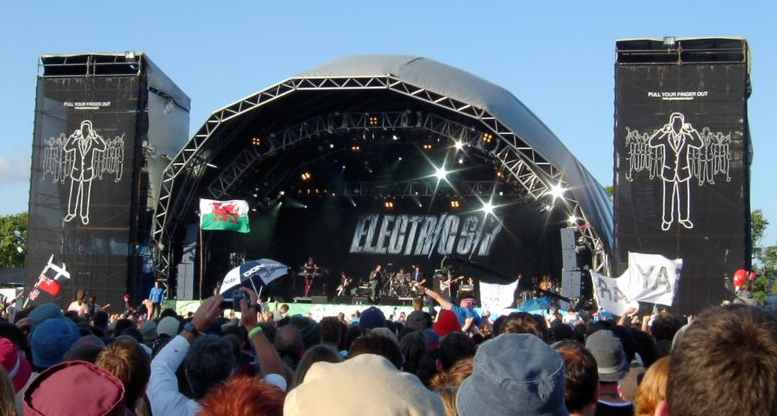
Glastonbury
Festival Stage 2003
Festival
Site
The
festival takes place at Worthy Farm between the small
village of Pilton
and Pylle,
six miles
west of Glastonbury
town overlooking the famous landmark Glastonbury
Tor in the mystical "Vale of Avalon".
The nearest town to the festival site is Shepton
Mallet, three miles north east, but there continues
to be interaction between the people espousing
alternative lifestyles living in Glastonbury and the
festival itself. The farm is situated between the A361
and A37
roads.
Worthy
farm is situated in a valley at the head of the
Whitelake River, between two low limestone
ridges, part of the southern edge of the Mendip
Hills. On the site is a confluence
of the two small streams that make the Whitelake River.
In the past the site has experienced problems with flooding,
though after the floods that occured during the 1997
and 1998
festival, drainage was improved. This did not prevent flooding during the
2005
festival, but allowed the floodwaters to disipate within
hours. The Bridgwater
branch of the Somerset
and Dorset Joint Railway ran through the farm on an
embankment, but was dismantled in the late 1960s
and now forms a main thoroughfare across the site.
Another prominant feature is the high-voltage
electricity line which crosses the site east-west.
In
recent years the site has been organised around a
restricted backstage compound, with the pyramid stage on
the north, and other stage on the south of the compound.
Attractions on the east of the site include the
accoustic tent, comedy tent and circus. To the south are
the greenfields, which include displays of traditional
and environmentally friendly crafts. In King's Meadow,
the hill at the far south of the site, is a small megalith
circle which, like Stonehenge,
is coordinated with the summer
solstice. The circle was constructed in 1990
with the appearance of age, and has no archaeological
interest.
The
backstage compound, restricted to normal festivalgoers,
is populated almost entirely by bands and their support
crews. The backstage bar, Lulu's, is, ironically, the
cheapest bar at the festival, and hosts many charity
functions and auctions.
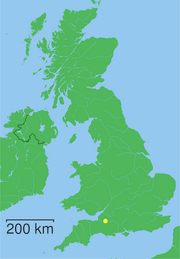
Map
for Glastonbury Festival at grid
ref ST590397
Organisation
The
festival is organised by local farmer and site owner Michael
Eavis, who has hosted the event since its inception.
More recently, the Mean
Fiddler Organisation, now controlled by Clearchannel,
a US-based media conglomerate, have taken a 40% stake in
the festival. Some sources now report that Michael's
daughter Emily
Eavis is taking a more proactive role in organising
the festival, with Michael increasingly taking a back
seat.
Several
stages and areas are managed independently, such as The
Left Field which is managed by a cooperative
owned by the Trades
Union Congress, and a field run by Greenpeace.
With
the exception of technical and security staff, the
festival is mainly run by volunteers. Stewards are
organised by the aid charity Oxfam
and the bars
are organised by the Workers
Beer Company, sponsored by Budweiser,
who recruit teams of volunteer staff from small
charities. In return for their help, typically around 18
hours over the festival, volunteers are paid in free
entry, transport and food, while their charities are
given donations by the organisers.
Catering,
and some retail services, are provided by various small
companies, typically mobile catering vans. The camping
retail chain Millets,
and many independent shops, set up makeshift outlets at
the festival. Network
Recycling manage refuse on the site, and in 2004
recycled 300 tonnes
and composted
110 tonnes
of waste from the site.
Glastonbury
over time
This
section is largely based on A Brief History of the
Glastonbury Festival.
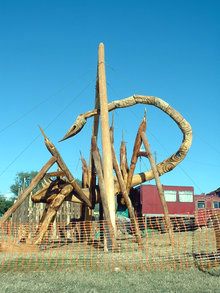
One
of the sculptures at Glastonbury
1970s
The
first festival, a smallscale event of 1,500 people
called the Pilton Festival, was in 1970,
followed by the larger scale Glastonbury Fayre of
1971.
Performers in the 1970s were generrally jazz and folk
artists. In 1971 the festival featured the first
incarnation of the "Pyramid Stage", built from
scaffolding and metal sheeting. The festival was not
held again until an unplanned event in 1978,
and a planned festival the following year which lost
money. The festival and has been an annual fixture since
1981,
albeit with breaks in 1988, 1991, 1996, 2001
and 2006.
1980s
In
1981
the festival was organised with the Campaign
for Nuclear Disarmament
(CND). That year a new
Pyramid Stage was constructed from telegraph poles and
metal sheeting (ironically, ex-Ministry
of Defence), a permanent structure which doubled as
a hay-barn and cow-shed during the winter.
In
the 1980s
the children's area of the festival (which had been
organized by Arabella
Churchill and others) became the starting point for
a new children's charity called Children's
World. 1981 was the first year that the festival
made profits, and Eavis donated £20,000 of them to CND.
In the following years donations were made to a number
of organisations, and since the end of the Cold
War the main beneficiaries have been Oxfam, Greenpeace,
and WaterAid
who all contribute towards the festival by providing
features and volunteers who work at the festival in
exchange for free entrance.
Since
1983
large festivals have required licenses from local
authorities. This led to certain restrictions being
placed on the festival, including a crowd limit and
times during which the stages could operate. The crowd
limit was initially set at 30,000 but has grown every
year to over 100,000. In 1985
the festival grew too large for Worthy Farm, but
neighbouring Cockmill farm was purchased.
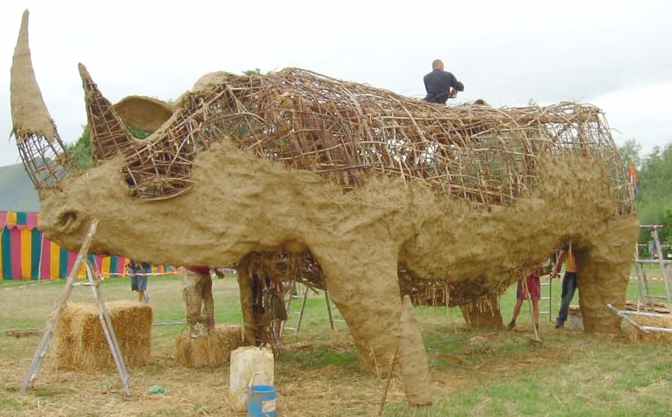
Another
sculpture at Glastonbury
1990s
In
recent years the festival has grown with new tents and
stages included a Dance
music tent, the Jazz
and World
music stage, the Glade - an open air dance area
which has now spawned an independent
festival - and The
Leftfield - a tent organised by Trade
unions which also appears at a number of other
British festivals. Since 1994
the festival has also been televised, first by Channel
4 and now by the BBC.
A
few weeks before the 1994 festival, the Pyramid Stage
burnt down. A temporary main stage was used until a new
permanent structure was constructed in 2000.
The 1994 festival also saw the introduction of the 150kw
wind
turbine which provides some of the festival power.
During
the 1990s
the festival suffered from increased overcrowding and
crime due to a culture of gate-crashing. By 2000,
a significant proportion of those at the festival gained
entrance to the site 'unofficially' (common estimates
put the number of 'fence jumpers' at around 100,000,
which pushed the total attendance up to 250,000 people).
In
1997
the site became famous for its mud,
but 1998
was even worse after several days of heavy rain hit the
West Country before the festival opened, and the site
flooded. 1998 was also the first year that attendance
broke the 100,000 mark.
2000
Acts:
Chemical
Brothers, Moby, Travis, Morcheeba, Basement
Jaxx and David
Bowie
In
2000
the third Pyramid Stage was introduced, a 100ft
silver structure, also doubling as a winter barn, and a
new area, The
Glade was also added. Widespread gatecrashing led to
the festival taking a break during 2001 while new anti-gatecrashing
measures were devised.
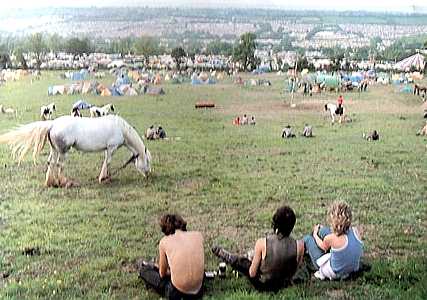
2002
Headline
acts: Coldplay, Stereophonics, Rod
Stewart
In
2002
the festival returned after a break with a substantial
surrounding fence (dubbed the 'superfence') that reduced
numbers to the levels of a decade earlier. The lower
attendance led to a much more relaxed atmosphere and
massively reduced crime levels compared to previous
years. There were some incidents outside the fence
involving frustrated individuals who arrived at the
festival assuming they would be able to jump the fence,
but despite this the event was hailed as a great success.
2003
Headline
acts: REM, Radiohead, Moby
By
2003
people got the idea that it was no longer possible to
crash the festival and hence it is recognised as one of
the most successful years to date as well as selling out
within hours of tickets going on sale. The number of
tickets available to the public was increased slightly
over 2002,
partially in response to criticism that the 2002
festival was underpopulated and lacked atmosphere. This
was the first year that tickets sold out before the
lineup was announced.
From
the ticket and commercial license sales charities
received more than £1million, half of which went to
Oxfam, Greenpeace and Water Aid.
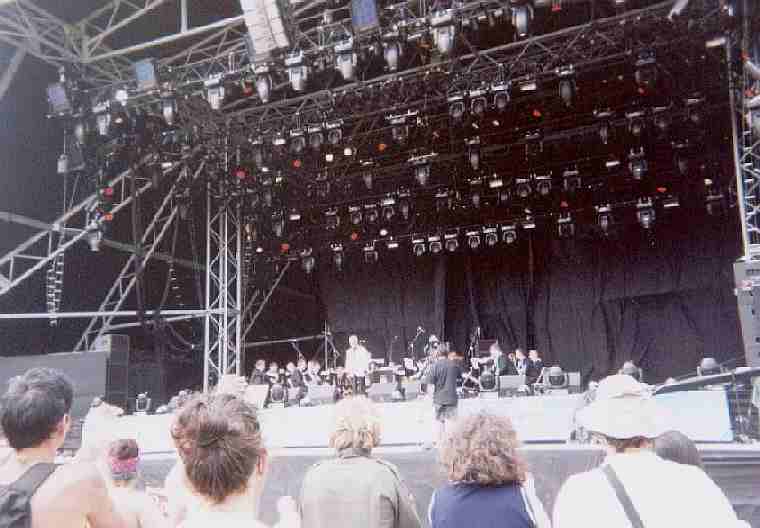
2004
Headline
acts: Oasis, Paul
McCartney, Muse
In
2004
tickets sold out within 24 hours amid much controvesy
over the ticket ordering process, which left many
potential festival goers trying for hours to connect to
the overloaded telephone and internet sites. The website
got two million attempted connections within the first
five minutes of the tickets going on sale and an average
of 2,500 people on the phone lines every minute. The
festival was not hit by extreme weather, but high winds
on the Wednesday delayed entry, and steady rain
throughout Saturday turned some areas of the site to mud.
Headline
acts:
The lineup for the 2004
Festival was officially announced on 2004-06-01. Oasis, Paul
McCartney and Muse
headlined the Pyramid Stage on Friday, Saturday and
Sunday respectively, whilst the Chemical
Brothers, Basement
Jaxx and Orbital
headlined the Other Stage. Other bands appearing
included the Raveonettes
(New Tent), Simple
Kid (Acoustic Tent), Baghdaddies
(Avalon Stage) and Sister
Sledge (Dance Tent). In addition 2004 was the
inaugural year of the festival's Unsigned Performers
competition to play main stages. The
Subways took the title and played the Other Stage.
After
the 2004 festival, Eavis commented that 2006
would be a year off - in keeping with the previous
history of taking one "fallow year" in every
five to give the villagers and surrounding areas a rest
from the yearly disruption. This was confirmed after the
licence for 2005
was granted.
2005
Headline
acts: The
White Stripes, Coldplay, Basement
Jaxx
As
in previous years, the 112,500 2005
tickets sold out rapidly - in this case in 3 hours 20
minutes,
leaving many thousands of potential attendees
frustrated.
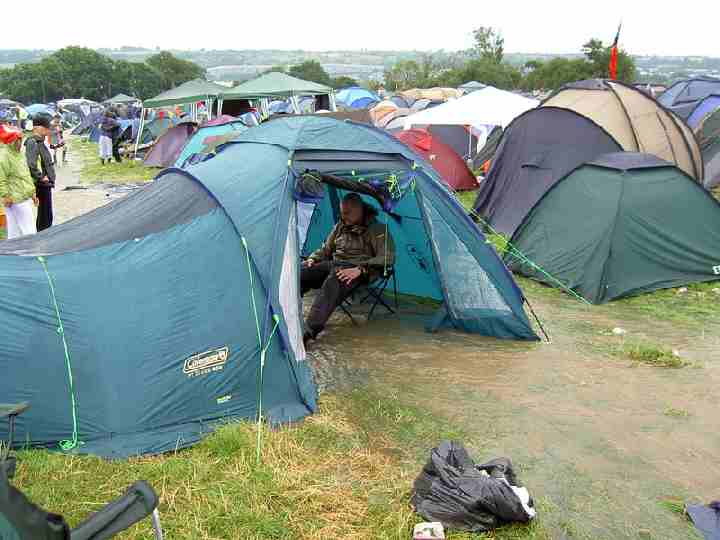
Friday
morning floods
The
Sunday headliner was originally scheduled to be Kylie
Minogue, but she pulled out in May to receive
treatment for breast
cancer.
Basement Jaxx were announced as a replacement on June
6. Other notables who performed include New
Order, The
Killers, Kaiser
Chiefs, Doves, Kasabian, Interpol, Athlete, Razorlight, Bloc
Party, British
Sea Power, Primal
Scream, Ian
Brown and Brian
Wilson.
2005
saw a big increase in the number of dance music
attractions, with the multiple tents of the Dance
Village replacing the solitary dance tent of previous
years. This new area contained the East and West dance
tents, the Dance Lounge, Roots Stage, and Pussy Parlour,
as well as a relocated G Stage, formerly situated in the
Glade.
The
opening day of the festival was delayed after several
stages, and one of the bars
were hit by lightning,
and the valley was hit by flooding that left some areas
of the site under a foot
of water,
flooding several campsites and seriously disrupting site
services.
Following
the death of DJ John
Peel in the previous autumn, the New Bands Tent was
renamed the John Peel Tent, in homage to his
encouragement and love of new bands at Glastonbury.
The
Glastonbury Festival is under way after suffering
serious disruption when storms tore across its site at
Pilton, Somerset, on Friday morning 24 June 2005.
Heavy
rain flooded parts of the site, with dozens of tents
lost under water, while lightning strikes affected the
stages and knocked out power lines. Bands such as
The White Stripes, Doves and The Killers are due to play
at the event, with 112,500 people expected. No
serious injuries were reported, but conditions are
expected to stay muddy.
Ambulance staff reported nine emergency cases, but none
of the people involved turned out to be seriously
injured. Organisers said under 100 tents had been
washed away, and facilities had been set up to hand out
clothing and new tents for those affected.
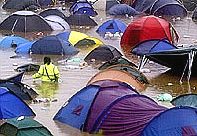
Sinking
toilets
Streams
running through the site burst their banks at the height
of the storm, with some gates to the site closed because
of waterlogging. Portable toilets sank in the mud, as
did one of the bars.
One
festival-goer was even seen swimming to his tent to
retrieve his belongings - something medical staff are
advising against. Festival-goers
have also been advised to wash their hands after using
the toilets, and not to eat food which has been in the
water, because of the risk of bacteria from the sunken
toilets.
Broadcasters were also affected - the set constructed
for BBC Three's coverage from Glastonbury was flooded
while Radio 1's Jo Whiley had to abandon her live
broadcast after a river close to the corporation's
compound burst its banks. Local fire crews
assisted in pumping the water off the site.
LINKS:
List
of music festivals in the United Kingdom
The
official site of Glastonbury Festival
So,
what is Glastonbury Festival?
A
Brief History of the Glastonbury Festival: 1970 to date
Glastonbury
Festival BBC Music
Glastonbury
Festival on eFestivals
Guardian
Unlimited Glastonbury Festival from The
Guardian newspaper
Glastonbury
2005 @ Playlouder
Avon
and Somerset Constabulary Glastonbury Festival
Glastonbury
- a film by Julien Temple and Glastonbury
2006 at Internet
Movie Database
Glastonbury
the movie
Glastonbury
Festival, 2004. "So,
what is Glastonbury Festival?."
Glastonbury
Festival, 2005. "Glastonbury
Festival Line-Up 2005."
Smith,
David, 2005. "Far-out
Man." In The
Observer.
BBC
News, 2005. "Crime
is down at Glastonbury site."
Glastonbury
Festival, 2005. "King's
Meadow."
The
Leftfield Cooperative, 2005. "About
the Left Field."
Glastonbury
Festival, 2005. "The
Greenpeace Field."
Glastonbury
Festival, 2004. "Composting
First for Glastonbury Festival."
Glastonbury
Festival, 1997-2005. "A
Brief History of the Glastonbury Festival: 1970 to date."
BBC
News, 2004. "The
Glastonbury Years."
Bishop,
Tom, 2004. "Glastonbury
spirit defies the rain". In BBC News.
Guardian
Unlimited, 2004. "Glastonbury
2004 full lineup and timings."
The
Guardian, 2005-05-17. "Kylie
diagnosed with breast cancer."
Glastonbury
Festival, 2005 "The
Dance Village: Welcome To Our Field of Dreams."
The
Guardian, 2005-04-04. "Ten
sales a second: Glastonbury tickets go in record rush."
BBC
News, 2005-06-24. "Soaked
Glastonbury gets under way."
Unofficial
US Live Aid site
Unofficial
Live Aid fan site
Official
Live Aid DVD site
BBC
news stories about the Live Aid DVD
Unofficial
Behind the Scenes site
http://www.herald.co.uk/local_info/live_aid.html
http://news.bbc.co.uk/1/hi/entertainment/music/3604680.stm
http://news.bbc.co.uk/1/hi/entertainment/music/3530269.stm
David
Rieff, Prospect Magazine, July 2005,
"Dangerous pity"
Live
8 Central
Faithful
believe music can teach caring
Countdown
to Live 8
From
Live Aid to Live 8: Bryan Adams
Pop
unites against poverty
Live
8 lineup
MTV,
VH1 to air Live 8 live
Scotland
joins effort
Organizers
add new shows
Rapper
50 Cent backs out of Live 8
Destiny's
Child, Linkin Park join the cause
Motley
Crue, Adams to perform in Canada
LIVE
8 MORE STORIES
MUSIC
INDEX A - Z

New
energy drinks for adventure capitalists

Solar
Red | Solar
Crush | Solar
Cola | Solar
Citrus | Solar
Spice
|








